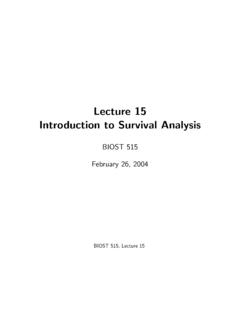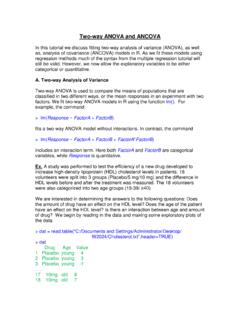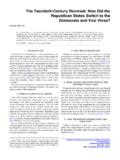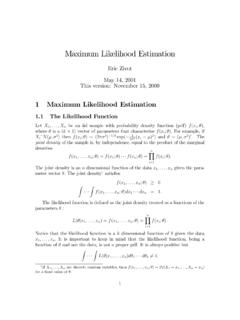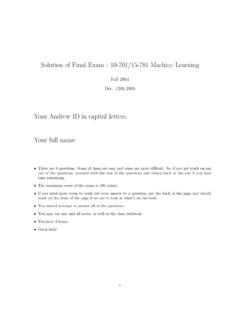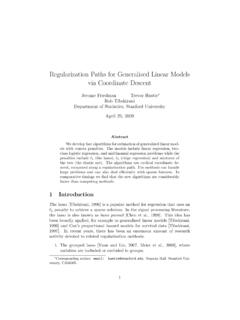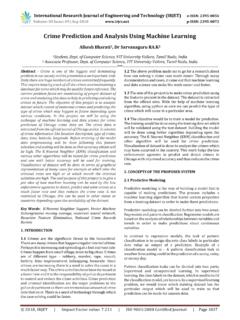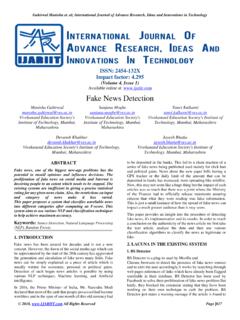Transcription of Causal inference using regression on the treatment variable
1 CHAPTER 9 Causal inference using regression on thetreatment Causal inference and predictive comparisonsSo far, we have been interpreting regressionspredictively: given the values of severalinputs, the fitted model allows us to predicty, considering thendata points as asimple random sample from a hypothetical infinite superpopulation or probabilitydistribution. Then we can make comparisons across differentcombinations of valuesfor these chapter and the next considercausal inference , which concerns whatwouldhappento an outcomeyas a result of a hypothesized treatment or a regression framework, the treatment can be written as a variableT:1Ti={1 if unitireceives the treatment 0 if unitireceives the control, or, for a continuous treatment ,Ti= level of the treatment assigned to the usual regression context, predictive inference relates to comparisonsbetweenunits, whereas Causal inference addresses comparisons of different treatments ifapplied to thesameunits.}
2 More generally, Causal inference can be viewed as aspecial case of prediction in which the goal is to predict whatwould have happenedunder different treatment options. We shall discuss this theoretical framework morethoroughly in Section Causal interpretations of regression coefficients can onlybe justified by relying on much stricter assumptions than areneeded for motivate the detailed study of regression models for Causal effects, we presenttwo simple examples in which predictive comparisons do not yield appropriatecausal example of zero Causal effect but positive predictive comparisonConsider a hypothetical medical experiment in which 100 patients receive the treat-ment and 100 receive the control condition. In this scenario, the Causal effect rep-resents a comparison between what would have happened to a given patient hadhe or she received the treatment compared to what would have happened undercontrol.
3 We first suppose that the treatment would have no effect on the healthstatus of any given patient, compared with what would have happened under thecontrol. That is, thecausal effectof the treatment is , let us further suppose that treated and control groups systematicallydiffer, with healthier patients receiving the treatment andsicker patients receiving1We use a capital letter for the vectorT(violating our usual rule of reserving capitals formatrices) in order to emphasize the treatment as a key variable in Causal analyses, and also toavoid potential confusion witht, which we sometimes use for time. 167168 Causal inference using DIRECT REGRESSIOND istribution of measurements after experimentPreviousif assigned theif assigned thehealth statuscontrol conditiontreatmentPoor1234512345 Fair1234512345 Good1234512345 Figure scenario ofzero Causal effectof treatment : for any value of pre-vious health status, the distributions of potential outcomes areidenticalunder control andtreatment.
4 However, thepredictive comparisonbetween treatment and control could bepositive, if healthier patients receive the treatment and sicker patients receive the of measurements after experimentPreviousif assigned theif assigned thehealth statuscontrol conditiontreatmentPoor1234512345 Fair1234512345 Good1234512345 Figure scenario ofpositive Causal effectof treatment : for any value ofprevious health status, the distributions of potential outcomes are centered athighervaluesfor treatment than for control. However, thepredictive comparisonbetween treatment andcontrol could be zero, if sicker patients receive the treatment and healthier patients receivethe control condition. Compare to Figure control. This scenario is illustrated in Figure , where the distribution ofoutcome health status measurements is centered at the same place for the treatmentand control conditions within each previous health status category (reflecting thelack of Causal effect) but the heights of each distribution reflect the differentialproportions of the sample that fell in each condition.
5 This scenario leads to a positivepredictive comparisonbetween the treatment and control groups, even though thecausal effect is zero. This sort of discrepancy between the predictive comparisonand the Causal effect is sometimes called self-selection bias, or simply selection bias,because participants are selecting themselves into different example of positive Causal effect but zero positive predictivecomparisonConversely, it is possible for a truly nonzero treatment effect to not show up in thepredictive comparison. Figure illustrates. In this scenario, the treatment has apositive effect for all patients, whatever their previous health status, as displayedCAUSAL inference AND PREDICTIVE COMPARISONS169by outcome distributions that for the treatment group are centered one point tothe right of the corresponding (same previous health status) distributions in thecontrol group.
6 So, for any given unit, we would expect the outcome to be betterunder treatment than control. However, suppose that this time, sicker patients aregiven the treatment and healthier patients are assigned to the control condition,as illustrated by the different heights of these distributions. It is then possible tosee equal average outcomes of patients in the two groups, with sick patients whoreceived the treatment canceling out healthy patients who received the health status plays an important role in both thesescenarios becauseit is related both to treatment assignment and future healthstatus. If a causalestimate is desired, simple comparisons of average outcomes across groups thatignore this variable will be misleading because the effect ofthe treatment willbe confounded with the effect of previous health status. For this reason, suchpredictors are sometimes calledconfounding regression predictors; omitted or lurking variablesThe preceding theoretical examples illustrate how a simplepredictive comparison isnot necessarily an appropriate estimate of a Causal effect.
7 In these simple examples,however, there is a simple solution, which is to compare treated and control unitsconditional on previous health status. Intuitively, the simplest way to do this is tocompare the averages of the current health status measurements across treatmentgroups only within each previous health status category; wediscuss this kind ofsubclassification strategy in Section way to estimate the Causal effect in this scenario is to regress the outcomeon two inputs: the treatment indicator and previous health status. If health statusis the only confounding covariate that is, the only variable that predicts both thetreatment and the outcome and if the regression model is properly specified, thenthe coefficient of the treatment indicator corresponds to theaverage Causal effect inthe sample. In this example a simple way to avoid possible misspecification wouldbe to discretize health status using indicator variables rather than including it asa single continuous general, then, Causal effects can be estimated using regression if the modelincludes all confounding covariates (predictors that can affect treatment assignmentor the outcome) and if the model is correct.
8 If the confounding covariates are allobserved (as in this example), then accurate estimation comes down to propermodeling and the extent to which the model is forced to extrapolate beyond thesupport of the data. If the confounding covariates are not observed (for example, ifwe suspect that healthier patients received the treatment ,but no accurate measureof previous health status is included in the model), then they are omitted or lurking variables that complicate the quest to estimate Causal consider these issues in more detail in the rest of this chapter and the next,but first we will provide some intuition in the form of an algebraic for omitted variable biasWe can quantify the bias incurred by excluding a confoundingcovariate in thecontext where a simple linear regression model is appropriate and there is only oneconfounding covariate. First define the correct specification asyi= 0+ 1Ti+ 2xi+ i( )170 Causal inference using DIRECT regression whereTiis the treatment andxiis the covariate for instead the confounding covariate,xi, is ignored, one can fit the modelyi= 0+ 1Ti+ iWhat is the relation between these models?
9 To understand, ithelps to define athird regression ,xi= 0+ 1Ti+ iIf we substitute this representation ofxinto the original, correct, equation, andrearrange terms, we getyi= 0+ 2 0+ ( 1+ 2 1)Ti+ i+ 2 i( )Equating the coefficients ofTin ( ) and ( ) yields 1= 1+ 2 1 This correspondence helps demonstrate the definition of a confounding covariate. Ifthere is no association between the treatment and the purported confounder (thatis, 1= 0) or if there is no association between the outcome and the confounder(that is, 2= 0) then the variable is not a confounder because there will be no bias( 2 1= 0).This formula is commonly presented in regression texts as a way of describingthe bias that can be incurred if a model is specified incorrectly. However, this termhas little meaning outside of a context in which one is attempting to make The fundamental problem of Causal inferenceWe begin by considering the problem of estimating the causaleffect of a treatmentcompared to a control, for example in a medical experiment.
10 Formally, thecausaleffectof a treatmentTon an outcomeyfor an observational or experimental unitican be defined by comparisons between the outcomes that wouldhave occurredunder each of the different treatment possibilities. With a binary treatmentTtakingon the value 0 (control) or 1 ( treatment ), we can definepotential outcomes,y0iandy1ifor unitias the outcomes that would be observed under control and treatmentconditions, (These ideas can also be directly generalized to the case ofa treatment variable with multiple levels.)The problemFor someone assigned to the treatment condition (that is,Ti= 1),y1iis observedandy0iis the unobservedcounterfactualoutcome it represents whatwould havehappened to the individual if assigned to control. Conversely, for control units,y0iis observed andy1iis counterfactual. In either case, a simple treatment effectforunitican be defined astreatment effect for uniti=y1i y0iFigure displays hypothetical data for an experiment with 100 units (and thus200 potential outcomes).



